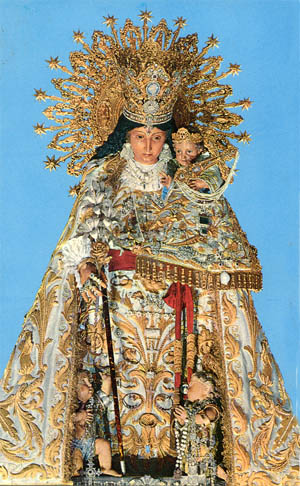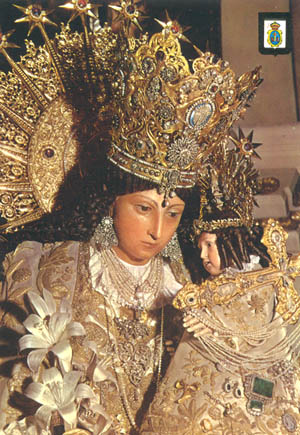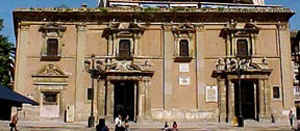 |
Feast Days of Our Lady
Our Lady of the Abandoned Ones – May 12
(Virgen de los Desamparados)
Prof. Plinio Corrêa de Oliveira
Biographical selection:

Our Lady of the Abandoned Ones
|
Today in Valencia, Spain, it is the feast day of Our Lady of the Abandoned Ones (Virgen de los Desamparados). In the 15th century, a confraternity was founded in Valencia to take care of abandoned children, under the invocation of Our Lady of the Abandoned Ones. The institute was established but lacked a statue to preside over it.
One day three extraordinarily handsome youths knocked on its door, asking for asylum. They offered to carve the needed statue in payment for shelter. They only asked that appropriate material be provided and that they be left alone and undisturbed in a room to work at ease for three days. The offer was accepted.
During the three days, the youths remained locked in the room. At the end of that time, the brothers went to inquire if they needed anything. The door was locked and no one responded to their requests to open it. Finally, they forced the door open and entered, but there was no sign of the three young men.
Instead, in the center of the room they found a majestic and protective statue of Our Lady that the young men had carved. This extraordinary fact was followed by countless miracles worked on behalf of the Virgen de los Desamparados. In 1885 Our Lady of the Abandoned Ones was proclaimed Patroness of Valencia.
Comments of Prof. Plinio
Here you see how this devotion to Our Lady of the Abandoned Ones started. As with so many others, it began with a wonder, a marvel, a miracle. Those three youths who appeared in Valencia were probably three Angels who enveloped what they would do in mystery and expectation.

Nuestra Señora de los Desamparados, Patroness of Valencia
|
The fact of being extraordinarily handsome boys asking shelter already hints of some mystery: Would they be princes or nobles? Perhaps they were the sons of some family of high lineage who needed to hide their children for a while and would later come to retrieve them or place them elsewhere. Many such conjectures could have been made by the brothers who received them.
Another enigma was their peculiar proposition. Probably they seemed capable children, but would they be skillful enough to carve a beautiful statue? Again, another mystery. Then, the work began, but no one was permitted to enter or check its development. Some of the brothers or children who lived in the asylum most probably stood outside the door to see if they could hear something. Perhaps one heard a marvelous hymn being sung inside, another would recount that he was overcome by a supernatural atmosphere emanating from the locked room.
When the three days were over, some of the head brothers went to see what had been accomplished. Inside the room was complete silence. The general curiosity grew. They knocked on the door, but there was no answer. They forced it open, but no one was there. What they found was a beautiful statue in the center of the room.
The selection found two very good adjectives to describe it: majestic and protective. It is beautiful to find this combination of majesty and protection. It signifies the goodness, mercy, and assistance that comes from a sovereign. So the expression of the statue and the name given it, Our Lady of the Abandoned Ones, fits perfectly with the institution for which it was made.

The Basilica of the Virgen de los Desamparados
|
At first, the title pertained specifically to the abandoned children. Then, as its fame spread with miracles, its first sense was amplified and the statue became Our Lady of all the abandoned, be they children, adults, or old people. The popularity of the devotion became such that she was proclaimed Patroness of Valencia and installed in a special chapel that became a Basilica dedicated to her, the Basilica of Our Lady of the Abandoned Ones.
Someone once told me this saying of St. Bonaventure that is linked to the devotion to Our Lady of the Abandoned Ones:
“When all human help fails, it is imperative that we not despair. For normally in this extreme situation, the divine help of Mary comes.”
That is, when man is completely abandoned, it is necessary to have hope, because this is the moment that Our Lady will give her assistance.


  | | Prof. Plinio Corrêa de Oliveira | |
The Saint of the Day features highlights from the lives of saints based on comments made by the late Prof. Plinio Corrêa de Oliveira. Following the example of St. John Bosco who used to make similar talks for the boys of his College, each evening it was Prof. Plinio’s custom to make a short commentary on the lives of the next day’s saint in a meeting for youth in order to encourage them in the practice of virtue and love for the Catholic Church. TIA thought that its readers could profit from these valuable commentaries.
The texts of both the biographical data and the comments come from personal notes taken by Atila S. Guimarães from 1964 to 1995. Given the fact that the source is a personal notebook, it is possible that at times the biographic notes transcribed here will not rigorously follow the original text read by Prof. Plinio. The commentaries have also been adapted and translated for TIA’s site.
|
Saint of the Day | Home | Books | CDs | Search | Contact Us | Donate

© 2002- Tradition in Action, Inc. All Rights Reserved
|
 |

|